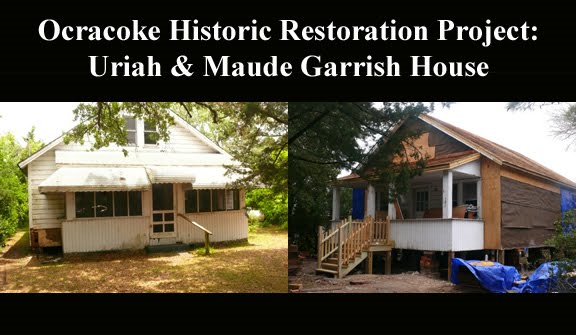I ran into Paula Schramel the other day and she raised some questions about insulation in old buildings. It happens that the questions she asked were on my mind relative to this building and also have been the subject of several ongoing discussions I have been having with some other builders here in Ocracoke. Because I find it interesting and because it is so critical to historic restoration, I thought I'd share some of this discussion in my next couple of blog entries.
Thermal efficiency in old buildings has been one of the issues that restoration professionals have grappled with for years without ever really finding a magic bullet solution. In fact, the debate is not just confined to restoration contracting, but includes the entire construction world, as it is a functional issue which is affected by practically every other decision made in designing and constructing buildings. It happens that those problems are magnified when you factor in an old building.
I've heard many carpenters say that building a house "too tight" will result in moisture problems and ultimately cause rotting in the structure etc. Well, there is plenty of evidence to support that conclusion, but a closer look at the evidence would likely suggest other problems than a house with too much insulation or walls that are unable to "breathe". There are really two ways a building is going to be wet - either by exterior source moisture penetrating through weaknesses in roofing, siding, flashing etc or by interior source moisture in the form of condensation collecting on relatively cold surfaces inside the building and sometimes even within the structure itself.
It is the second - the condensation process - that can be aggravated (though not caused) by improper placement of insulation and/or vapor barriers. Usually though, in our climate, condensation is not the culprit in a moisture problem and I think I can suggest convincing evidence: The most common example of condensation inside a house is when water collects on the inside of a window when it is cold outside and warm and humid inside. For that to occur, two factors must coincide - the inside air must be at or above a certain humidity level and the surface of the glass in the window must cold enough to cause the indoor air that flows over it to cool rapidly. That's called "reaching dew point" and you can imagine why you wouldn't want it to happen inside the walls of your house.
Now, here's my evidence in the form of a question: How often have you witnessed this in Ocracoke? Agreed, it can be common in bathrooms where the humidity is artificially pumped up by running a shower, but that's why bath fans are so important. So besides bathroom windows, how often do you witness condensation on your windows? Not often, I think. And the reason is that there is rarely enough temperature differential between the indoor air and the outdoor air in our climate to cause the window glass to reach dew point on the inside surface.
So what does that mean? It means that practically no matter how you design your walls and insulation in our climate, the key moisture issue is not going to be condensation. That's why it's OK to use felt paper on an outside wall here, where in a cold climate that would spell Disaster (with a capital D) - as the felt paper would act much like window glass does when it reaches dew point. So if we can eliminate condensation as a likely cause of moisture problems here, then why is rotted wood so common in our old (and even some new) Ocracoke houses? I'll get there in my next post.
Subscribe to:
Post Comments (Atom)

Greetings! Thank you for your interesting blog. I know absolutely nothing about restoration or even building in general. However, your entries have been both interesting and informative. I shall look forward to following the entire process on your restoration project. I do love Ocracoke and so imagining your home taking shape once again will be lots of fun to follow! I found out about your blog on Phillip Howard's site.
ReplyDeleteOcracokeFan
Another referee from Philip Howard's blog. Can you tell us wannabe Ocracokers a bit about the house, where's it located, a bit of its history, how you came to take it on as a project, your ultimate plans for it? Thanks. Always enjoy reading about goings-on on Ocracoke.
ReplyDeleteHey, thanks for the feedback. It's nice to know I'm not just blogging to an empty house...er so to speak.
ReplyDeleteAnyway, I appreciate Phillip's link. Indeed, I appreciate Phillip. If there be kinder and more gracious souls, there be few, to be sure.
As to more info on the location, history, plans, etc...stay tuned.
Thanks,
Tom